|
|
|
Sort Order |
|
|
|
Items / Page
|
|
|
|
|
|
|
| Srl | Item |
| 1 |
ID:
182806
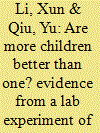

|
|
|
|
|
| Summary/Abstract |
This paper examines the impacts of siblings on people's social preference, risk attitude and time preference with a data set from a large-scale lab experiment. Employing the variation of fine rates under One-Child Policy for excess birth in different regions as instrument to address the endogeneity of whether having siblings, we find that sibling's role mainly focuses on shaping people's social preference that subjects with siblings demand less as responders in ultimatum game and behave more cooperatively in sequential prisoner's dilemma. This conclusion survives through several robustness checks. Our further result suggests that more sibling interactions and less parental expectations are two potential mechanisms through which siblings play a role in making people more prosocial. Our findings point to a positive externality along with Two-Child Policy which is widely neglected in both policy evaluation and relevant theory such as quantity-quality theory, and provide implications for the fertility policy such as the recent Three-Child Policy in China and beyond.
|
|
|
|
|
|
|
|
|
|
|
|
|
|
|
|
| 2 |
ID:
161804
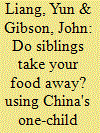

|
|
|
|
|
| Summary/Abstract |
We test for the existence of a trade-off between child quantity and child quality in Chinese families. We use changes over time and space in the local stringency of the one-child policy as a source of exogenous variation in family size. Investment in child quality is measured by intake of three nutrients, using seven waves of data from the China Health and Nutrition Survey. For all three nutrients a quantity-quality trade-off is apparent, which persists for fats if child-specific effects are introduced. The trade-off would be less apparent if exogenous sources of variation in family size were ignored.
|
|
|
|
|
|
|
|
|
|
|
|
|
|
|
|
| 3 |
ID:
182767
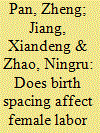

|
|
|
|
|
| Summary/Abstract |
This paper investigates the impact of birth spacing on female labor market participation in urban China. Employing household panel surveys between 1989 and 2011 and exploiting variations in time intervals between the first and second child, we find that spacing births at longer intervals significantly increases female labor market participation. The effects of birth spacing are robust to various examinations that consider nonlinear specifications, selection on observed and unobserved variables, and the plausibly exogenous instrument. The heterogeneous analysis suggests that the effects of birth spacing are more pronounced in women with a daughter as the first birth, women with late first birth, and less-educated women. We examine potential mechanisms and document that women with longer birth intervals are likely to invest more in continuing education and have better health status.
|
|
|
|
|
|
|
|
|
|
|
|
|
|
|
|
| 4 |
ID:
182742
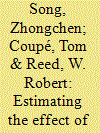

|
|
|
|
|
| Summary/Abstract |
Researchers have long puzzled over China's high household savings rate. Some have hypothesized that the explanation lies with China's One-Child Policy (OCP). According to this hypothesis, faced with fewer children to support them in their old age, Chinese parents increased their savings to finance retirement. Previous research relied on empirical studies of the relationship between children and saving behavior. However, all of these studies based their analysis on data after the OCP was implemented. Their implicit counterfactual for China without an OCP was households with multiple children living in an OCP environment. In contrast, we compare Chinese people with people from regions that do not have restrictive population policies. These regions share many cultural, demographic and economic characteristics with China that suggest they can be used as a counterfactual for China. This approach enables us to employ a Blinder-Oaxaca decomposition procedure to identify the different channels by which children could affect savings. Our results suggest that the OCP decreased households' proclivity to save. The estimated effects are generally small, in the range of one to two percentage points. We find no evidence to indicate that the OCP can explain China's high saving rate. An implication of our findings is that they suggest that the recent relaxation of the OCP cannot be counted upon to substantially boost Chinese consumption.
|
|
|
|
|
|
|
|
|
|
|
|
|
|
|
|
| 5 |
ID:
141718
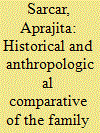

|
|
|
|
|
| Summary/Abstract |
The article tracks the evolution of the family planning programmes in India and China and the conceptual linkages between the two. This comparison, in turn, serves as an entry point for studying the following:
The role that the family plays in becoming the site of governance and deploying state-led capitalism in the two countries.
The assumptions behind the development trajectories in both countries.
What are the ways in which the policies amplified patrilineal hierarchies within families to produce the disturbing outcome of the missing girl child—this even as the family planning policies became constrained as they were acting within a cultural milieu of patriarchy.
The article uses studies and commentaries across disciplines, such as, historical demography and anthropology to situate its arguments. The conclusion it attempts to put forth is that the small family norm was operationalised in various differing ways in both states, and yet the commonalities that arose were the following:
The declining sex ratio in both states as an immediate repercussion of the enforcement of the small family norm.
The structuring of the health services around the family planning operations.
The small family norm becoming an end in itself, as a mode of reaching a level of development akin to the West, and as an ethic for modernising nations.
|
|
|
|
|
|
|
|
|
|
|
|
|
|
|
|
| 6 |
ID:
181143
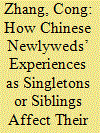

|
|
|
|
|
| Summary/Abstract |
Did growing up as singletons (only-children) convince young adults born under China's one-child policy of the superiority of singleton status and therefore the desirability of not having more than one child? This article draws on interviews with 52 childless newlyweds in Dalian, China, to help answer this question. We found that far from convincing them of the superiority of singleton status, the feelings of loneliness experienced by singletons in childhood and adulthood have convinced most of them that it is better to have a sibling than to be a singleton and thus it is better to have two children instead of one. Moreover, interviewees who did have siblings tended to corroborate singletons’ beliefs about how valuable a sibling can be in both childhood and adulthood.
|
|
|
|
|
|
|
|
|
|
|
|
|
|
|
|
| 7 |
ID:
147255
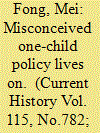

|
|
|
|
|
| Summary/Abstract |
Rules governing the size of Chinese families remain in place—and even with a recent loosening of the policy, it may be too late to avert demographic decline.
|
|
|
|
|
|
|
|
|
|
|
|
|
|
|
|
| 8 |
ID:
187827
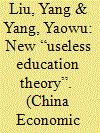

|
|
|
|
|
| Summary/Abstract |
Using data from the China Family Panel Studies (CFPS) 2010 and a strictly implemented one-child policy as a quasi-experiment, this paper analyses the changes in parents' educational expectations of their children and the underlying mechanisms in a fuzzy regression discontinuity framework. It was found that one-child policy compliers have lower educational expectations for their children after acquiring an advanced education than those who did not. The finding remains valid after robustness analysis and placebo tests. Combined with an examination of the intergenerational effects of birth, this finding may be related to parents' assessment of and responses to educational returns and equality of educational opportunities. It was also found that parents with lower educational attainment in the high-income group have higher educational expectations than those with higher educational attainment, while for those with lower income, there is no significant difference between higher educational attainment and otherwise, which indirectly verifies the causal inference of this paper. The finding of this study explains the new “useless education theory” and provides a new perspective for understanding the intergenerational transmission of education.
|
|
|
|
|
|
|
|
|
|
|
|
|
|
|
|
| 9 |
ID:
187869


|
|
|
|
|
| Summary/Abstract |
This study investigates how traditional patrilineal family institution influences women's income through fertility behavior by offering evidence from family lineage (zongzu) in China. We hypothesize that family with strong lineage—proxied by owning genealogy—has a negative effect on women's income through the son-targeting fertility behavior. Using a difference-in-differences strategy, this study confirms the hypothesis. Relative to the women whose first child is a son, the women marring into families owning genealogy indeed have more children and lower income, if their first child is a daughter. In contrast, such finding does not hold for the male sample. Preliminary evidence suggests that shorter work time can explain the findings.
|
|
|
|
|
|
|
|
|
|
|
|
|
|
|
|
|
|
|
|
|